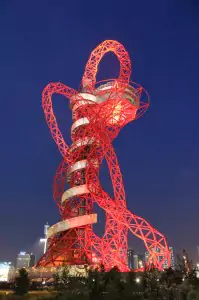By David Birch

✅ AI Essay Writer ✅ AI Detector ✅ Plagchecker ✅ Paraphraser
✅ Summarizer ✅ Citation Generator
 I tend to arrive in Stratford at night; the Jubilee brings me in, the Central takes me out. These days as I wait for my train, it’s hard to ignore the lurking sense that over my shoulder a parallel universe is growing. I always turn round, you can’t help but stare. The Westfield shopping centre rises over Stratford station with a kind of imminence. Illuminated M&S mannequins in a high distant window reveal what life is like inside. An enclosed bridge crosses above a moat of train lines and disappears into the complex.
I tend to arrive in Stratford at night; the Jubilee brings me in, the Central takes me out. These days as I wait for my train, it’s hard to ignore the lurking sense that over my shoulder a parallel universe is growing. I always turn round, you can’t help but stare. The Westfield shopping centre rises over Stratford station with a kind of imminence. Illuminated M&S mannequins in a high distant window reveal what life is like inside. An enclosed bridge crosses above a moat of train lines and disappears into the complex.
Squinting through the darkness, I’ve been following the construction of Anish Kapoor’s monumental observation tower: the Arcelormittal Orbit. I saw the press release months ago and now here it almost is. It fills me with a kind of excitement: not the excitement of seeing something imagined become real, but of something real become imagined. It’s really taking shape, though that’s hardly the right idiom. From my viewpoint on the platform, with Westfield in the foreground, the Orbit seems like a cross between an enormous skelter and a Christmas tree.
The Orbit invites comparisons. Described as congealed intestines, a melted roller coaster, a loop of string arrested in mid-fall, it seems we cannot talk about it without talking about other things. Instead of evaluation, we end up with similes. This tendency to describe what the structure is like betrays a sense of unease over what it is. The tower is, of course, strikingly redundant—an inept attempt to satisfy the vague sense that something is missing, another useless thingy to add to Stratford’s menagerie of future relics. But its uselessness is to the point: Boris Johnson and Anish Kapoor have said that the tower is ‘mythic,’ which both acknowledges its unreality and reveals that they want more than they know how to get.
The Orbit, Johnson has said, is being built to ‘justify’ the huge sums of money ‘invested’ in east London. In other words, the tower is being built to give reason to the Olympic project, to give it sense. As when newlyweds nauseously calculate the cost of their extravagance, there seems to be a recognition here that fantasy has got the better of reality, that we may have gotten a little carried away. But is the construction of a large steel squiggle really the most effective way of sobering up? Perhaps the recognition is rather that reality will soon get the better of the fantasy. If so, the solution would be to retreat further into fantasy. When the wax is melting, start kicking instead.
Towers are monuments to our uncertainties. When Johnson talks with hopeful vagueness of the ‘mythic’ nature of towers, the word he is really after is ‘magic.’ The Orbit was designed to make the Olympic Park a ‘must see’ destination; the Orbit, that is to say, is a coercion; all towers are. Towers attempt to convince us that they, and by extension we, stand at the centre of things. Stratford is now ‘Stratford City,’ and the difference is more than nominal; the name is a declaration of its importance, its centrehood. The tower, however, must not only declare Stratford as the centre, it must also constitute Stratford as the centre. The function of this useless object, Johnson has stated, is to keep drawing visitors to Stratford once the games have left. The Orbit is a hope for permanence.
A tower is a paranoid gesture. In his book on literary modernism, David Trotter writes, “The beginning of paranoia is the deep sense that it all hangs together.” A tower ratifies that deep sense. By standing at the centre of things, it reassures us of where we are, it defines our sense of place, it precludes our feeling peripheral and our feeling contingent. A tower neutralises the disorder of a city into a kind of project, ideal, or dream. It clears away the ground-level clutter; it makes it all hang together. We build towers when the mess of contingency becomes too much for us, or too little.
The Olympics realises a wish to participate in a vision of, and register our allegiance to, the ‘global village.’ As such, the Olympic project denies the possibility of a centre; the Olympic Park is designed to for all people from all places. For Britain, the games represent a kind of liberal (apolitical) utopia (dystopia with PR). We shouldn’t be scandalised by its expense and transience, by the spectacle of boom-and-bust condensed into a fortnight, for it is a global event. We will not be left with, and in, the mess as there is no ‘we’ as such, no ‘we’ in particular, only the global we.
If this picture of things begins to unnerve rather than inspire, we might start to hedge our bets, we might start to feel adrift and crave the certainty of a centre, the magic of a tower. Once the word ‘global’ starts to lose its meaning, the passing of the games may leave us feeling bereft.
The Orbit will continue to watch us even when the world has stopped. As Barthes wrote of the Eiffel Tower, “The Tower is an object which sees, a glance which is seen…[it] transgresses this habitual divorce of seeing and being seen.” We build towers when we worry that no one is watching: they are an artefact of secular doggedness. The French may have killed their king and lost their emperors, but through their ideology they continued to believe in their singularity. To celebrate the centenary of the French Revolution, they built the Eiffel Tower; the Tower marked the Revolution as their historical centre. It gave them a story.
Comparisons have been drawn between the Orbit and the Eiffel Tower. Indeed, where the receiving public have resorted to similes in attempt to understand what the Orbit is, its designers have given it a context—a faux genre—by placing it alongside Eiffel, Tatlin, and Babel (no mention of Blackpool—too regional). We have also been told that the tower is art, though there would seem to be a tension between its attempt at myth and its status as art. Towers are not art just as dictators are not politicians—they ask for our allegiance, not our approval. Art is always contained or framed, but a tower cannot be framed because it is the frame, it frames us, it turns us into the objects of a disinterested gaze. The Eiffel Tower constitutes Parisians as Parisians. The question cannot be whether the Orbit is good or bad, but whether it works, whether it becomes mythic, the object of daydreams.
The Eiffel Tower centres Paris. Barthes describes it as “a form which men unceasingly put meaning…it attracts meaning the way a lightning rod attracts thunderbolts.” The Tower works at being everything, at being mythic, because it is nothing, it is an utterly useless object, an empty monument. The Tower draws its life from the ground below; fantasies of Paris are absorbed and released through the Tower. Without Paris, the Eiffel would be a curiosity—without the Eiffel, there would be no Paris, the city as idea. Built at sea, the Tower would stand for nothing, its emptiness would be total, it would attract no meaning. The only international places on earth are the oceans. Their emptiness is their belonging to no one in particular, like a wilderness.
The Eiffel Tower creates and constitutes ideas of Paris. What is the idea that the Orbit is intending to create? Is it of Britain? London? East London? Stratford? What are the boundaries between these? How do we know one from the other? As far as the Olympics is concerned, Britain is London, and London is, to use David Cameron’s phrase following the riots, “an international success story.” The Orbit, that is to say, is being built on an ‘international’ site in order to create an idea of Britain as international. But this is an impossible wish. We cannot be centred on nowhere in particular. If we have no sense of where we are to begin with, a tower will not look imperious but embarrassed amid the skyline, like St Paul’s beside the Shard. A mirror only reflects if we have a sense of ourselves, a tower can only constitute a space if we have a sense of what it might mean to stand for something, to be different; paranoia, for us, starts to look blissfully naïve.
The Olympics offers a picture of Britain’s drab liberalism in which we have individuality without idiosyncrasy (freedom without imagination). The sports we most readily associate with the Olympics involve individuals who have trained tirelessly to become expert at performing narrowly defined tasks—they are mad to succeed over others and their success is quantified in terms of time and speed. This is the working life of a professional today.
If we feel that such lives are hollow, that something is missing, if we feel that our lives have too much change with too little direction, this sense of empty contingency will only be exacerbated by the expensive and fleeting nature of the Olympics. The Olympics undermines the permanence of structures; it undermines the capacity of structures to provide structure. But the Orbit cannot work as an antidote, it cannot hold it all together for a liberal utopia can have no centre. The physics of liberalism is without gravity; we are each our own centres (we are all threatened by each other). The Orbit is an impossible object, a tower centred on nothing, with a self-defeating purpose: to constitute Stratford as a place so that it will be visited by tourists. To commodify Stratford by predicating its future well-being on the attention of tourists is to eviscerate it as a place; it cannot both flourish and be consumed. Why must the good of Stratford depend on this? Why this appalling lack of imagination? If the Eiffel Tower is an empty monument, the Orbit is a monument to emptiness.
Barthes wrote that the Eiffel Tower is able to perform as an “infinite cipher” because of its simple, primary shape. Most towers are symmetrical and centre on themselves, they coerce us into their myths by embodying them. The arc of the Eiffel’s lines do not actually meet in the centre—the point of their convergence is implied, existing at an infinite vanishing point. Its centre is not stated but suggested—the Tower works its way into our minds by leaving our imaginations to complete it indefinitely; this is part of the Tower’s oneiric quality. To paraphrase Kierkegaard: a tower which cannot seduce us cannot save us either. A tower must be able to find its way into our daydreams, our mindless glances skywards, our doodles.
Towers become mythic only through their powers of seduction, their magic. Can the Orbit seduce us? It seems unlikely, the Orbit, which is dwarfed by the monumentality of Westfield, is a hysterical structure; it does not wear its impossibility lightly. In recognition of its predicament, it has no centre, is in constant transition, and looks unstable. These are features which Kapoor boasts of. Towers are centred, ordered, imperious, permanent, and certain. The Orbit is uncentred, disordered, liberal, transient, and hysterical. Is it a tower or the repudiation of one? If the latter, why was it selected by Johnson and his team?
A contradictory object would seem best qualified to realise an impossible wish. And perhaps the Orbit’s hysteria is a welcome distraction from its redundancy. By being unsure of itself, by being nothing in particular, perhaps it suspends the question of what is wanted from it. Or maybe the Orbit’s embodiment of the Olympic predicament forecloses one’s awareness of it. If the Orbit can seduce, maybe this is where its powers lie. And maybe the similes applied to it are subversive rather than confused, maybe they are a resistance to the tower’s pull, a refusal to be brought within the field of its emptiness. But when we have to resist the places we live in by making nonsense of them (pringles and gherkins and shards and intestines), where are we then? Kapoor gave a straightforward answer to that question: the Orbit is, he said, “truly 21st century.”
———————–
This was written under a Creative Commons License, with a few edits: https://creativecommons.org/licenses/by/1.0/
Follow us on Reddit for more insights and updates.





Comments (0)
Welcome to A*Help comments!
We’re all about debate and discussion at A*Help.
We value the diverse opinions of users, so you may find points of view that you don’t agree with. And that’s cool. However, there are certain things we’re not OK with: attempts to manipulate our data in any way, for example, or the posting of discriminative, offensive, hateful, or disparaging material.